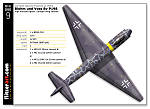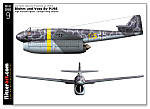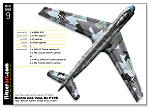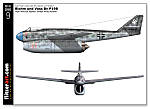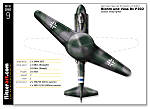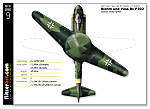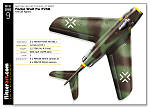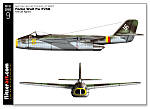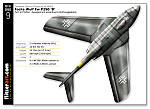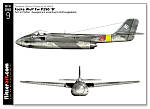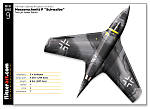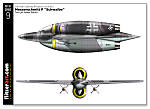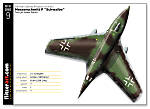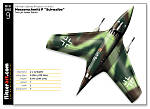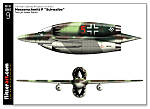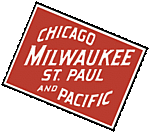1⁄35German WW2 Secret Projects Vol. 1
2
Comments
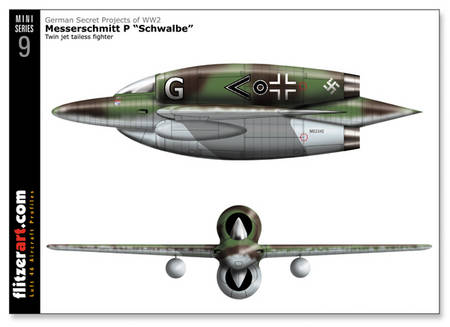
For this set I’ve made a slight return to where it all started with Holdfast’s simple question, “How do you choose colours for Luft 46 subjects?”. I’ve concentrated on four aircraft, two of which I’ve already profiled, but at a time when I had yet to discover many of the techniques I now use, but thought them worth a second look, especially where potential variants and developments are concerned. The other pair are all new, and there are still many more German Secret Projects that I have yet to try.
The Aircraft
Blohm und Voss P198Sometime in late 1943 or early 1944, B&V produced this high-altitude fighter design to utilise the massive BMW 018 turbojet, with an estimated 7700 lbs thrust on tap. The engine was mounted directly under the forward fuselage. The design featured a straight wing with slight tapering on both leading and trailing edges. The main undercarriage, housed in slight underwing bulges, retracted inward. The armoured and pressurised cockpit was placed well forward in the fuselage.
There was a swept wing version and the second profile is my interpretation of how it may have looked.
Blohm und Voss P202
This 1944 design featured a variable wing, achieved by rotating the whole wing, up to 35 degrees. This was thought to have the advantages of higher maximum speed when in the 35 degree swept position and better handling when in the straight position. The design proposed power by two BMW 003 jet engines and was armed with a MK 193 30 mm cannon on each side of the fuselage and one MG 151/20 200 mm cannon in the nose.
Focke Wulf P250
Professor Kurt Tank presented the Fw 250 design to the RLM late in 1944. It was well received and featured a wide fuselage accommodating twin Heinkel Hirth He S 011 jet engines that were buried side by side in the rear fuselage, fed by nose intakes. The wings were swept back at 40 degrees, with the main landing gear retracting inboard into the wing. The tail was set high to clear the jet exhaust and was mounted on a ‘boom’. The pilot sat in a pressurized cockpit far forward in the nose. The design would have been superior in climb and turning ability than the Messerschmitt 262 HG III, but would have been slower and would have had a longer development time. Ultimately the RLM thought it fell short of its potential and suggested further development including moving the engines further forward approximately 1 metre and to feed them via wing root intakes which allowed a solid nose. However the RLM soon after, ordered Focke Wulf to cease all further work on the Fw250 concept to concentrate on the Ta 183 Huckbien.
The first profile is how the concept was originally presented and the second profile is my interpretation of how the aircraft might have looked after the proposed development work.
Messerschmitt P “Schwalbe”
Messerschmitt penned this design very late in the war, so late in fact, it did not receive a project number, and is known only by its code name “Schwalbe” (Swallow). I could find no reference for its intended role but looking at the compact layout with two turbojets, I assume it was intended as a jet-propelled equivalent to the rocket powered Me 163/263, in the point interceptor role.
It looks like a real hot rod of a plane. Basically it is two double-decker stacked engines with a small nose and cockpit placed between the intakes and a pair of smallish swept wings attached mid way on the fuselage. The wings are most likely based on those of the Me163 and/or Me263. The bulk of the fuel was to be accommodated in the wings so range and mission duration would have been somewhat limited. Drop tanks may have been a possible method of extending these.
The original drawings make no provision for armament, but most experts suggest a pair of cannon would have been housed in the cheeks of the forward fuselage each side of the cockpit. The cross-section here is of a flattened diamond shape and probably would have been the best option.
Its also suggested a pair of Ruhrstalh/Kramer X4 missiles may have been carried under the wings or gun/cannon pods to add fire power.
The first profile shows Ruhrstalh/Kramer X4 missiles mounted under the wings, the second profile shows drop tanks and the third is with gun pods.
That’s it for now but there’s more in the pipeline, so until next time....
Comments
Absolutely stunning work Peter! You never get tired of seeing your beautiful profiles..... Focke Wulf P250 is my favorite.
Keep them coming please..
MAR 30, 2007 - 03:41 PM
Just fantastic - as always! I really appreciate these profiles. Even more now as I have a few Luft 46 projects in my stash.
Keep them coming - and thanks for your time and effort.
APR 01, 2007 - 12:03 PM
Copyright ©2021 by Peter Allen. Images also by copyright holder unless otherwise noted. The views and opinions expressed herein are solely the views and opinions of the authors and/or contributors to this Web site and do not necessarily represent the views and/or opinions of AeroScale, KitMaker Network, or Silver Star Enterrpises. Images also by copyright holder unless otherwise noted. Opinions expressed are those of the author(s) and not necessarily those of AeroScale. All rights reserved. Originally published on: 2007-03-31 00:00:00. Unique Reads: 21050




